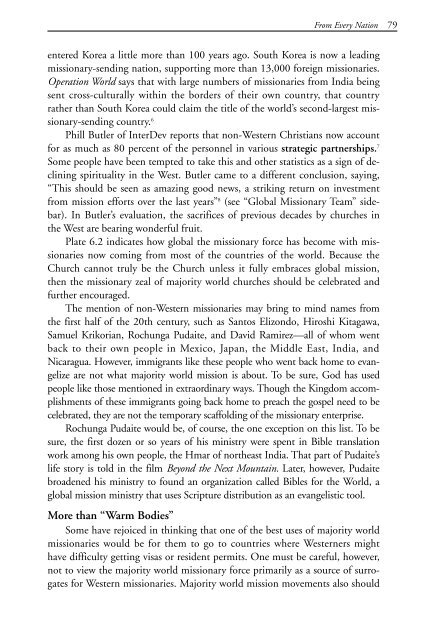discovering missions - Southern Nazarene University
discovering missions - Southern Nazarene University
discovering missions - Southern Nazarene University
You also want an ePaper? Increase the reach of your titles
YUMPU automatically turns print PDFs into web optimized ePapers that Google loves.
245187 Disc Missions ins 9/6/07 1:04 PM Page 79<br />
From Every Nation 79<br />
entered Korea a little more than 100 years ago. South Korea is now a leading<br />
missionary-sending nation, supporting more than 13,000 foreign missionaries.<br />
Operation World says that with large numbers of missionaries from India being<br />
sent cross-culturally within the borders of their own country, that country<br />
rather than South Korea could claim the title of the world’s second-largest missionary-sending<br />
country. 6<br />
Phill Butler of InterDev reports that non-Western Christians now account<br />
for as much as 80 percent of the personnel in various strategic partnerships. 7<br />
Some people have been tempted to take this and other statistics as a sign of declining<br />
spirituality in the West. Butler came to a different conclusion, saying,<br />
“This should be seen as amazing good news, a striking return on investment<br />
from mission efforts over the last years” 8 (see “Global Missionary Team” sidebar).<br />
In Butler’s evaluation, the sacrifices of previous decades by churches in<br />
the West are bearing wonderful fruit.<br />
Plate 6.2 indicates how global the missionary force has become with missionaries<br />
now coming from most of the countries of the world. Because the<br />
Church cannot truly be the Church unless it fully embraces global mission,<br />
then the missionary zeal of majority world churches should be celebrated and<br />
further encouraged.<br />
The mention of non-Western missionaries may bring to mind names from<br />
the first half of the 20th century, such as Santos Elizondo, Hiroshi Kitagawa,<br />
Samuel Krikorian, Rochunga Pudaite, and David Ramirez—all of whom went<br />
back to their own people in Mexico, Japan, the Middle East, India, and<br />
Nicaragua. However, immigrants like these people who went back home to evangelize<br />
are not what majority world mission is about. To be sure, God has used<br />
people like those mentioned in extraordinary ways. Though the Kingdom accomplishments<br />
of these immigrants going back home to preach the gospel need to be<br />
celebrated, they are not the temporary scaffolding of the missionary enterprise.<br />
Rochunga Pudaite would be, of course, the one exception on this list. To be<br />
sure, the first dozen or so years of his ministry were spent in Bible translation<br />
work among his own people, the Hmar of northeast India. That part of Pudaite’s<br />
life story is told in the film Beyond the Next Mountain. Later, however, Pudaite<br />
broadened his ministry to found an organization called Bibles for the World, a<br />
global mission ministry that uses Scripture distribution as an evangelistic tool.<br />
More than “Warm Bodies”<br />
Some have rejoiced in thinking that one of the best uses of majority world<br />
missionaries would be for them to go to countries where Westerners might<br />
have difficulty getting visas or resident permits. One must be careful, however,<br />
not to view the majority world missionary force primarily as a source of surrogates<br />
for Western missionaries. Majority world mission movements also should

















